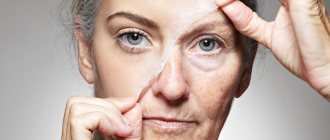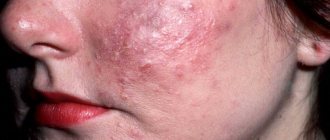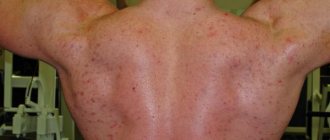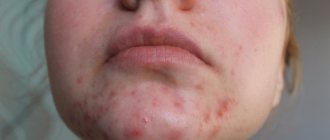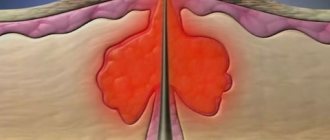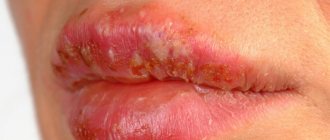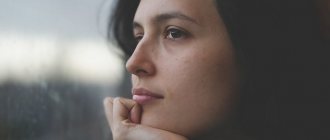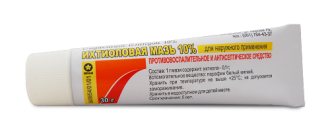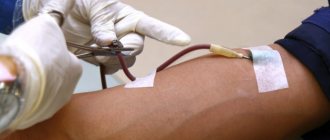Skin problems: Acne, blackheads, comedones, blackheads
A very important event is approaching, but acne appears on your face that is not at all decorative? And your nose is covered in black spots? And the mirror in the bathroom with its treacherously wonderful lighting shows all the imperfections on the face, like on a topographical map of the world? There is an exit!
Like the law of meanness, skin that was perfect up to this point, in an instant becomes covered with imperfections. We begin frantically going through our makeup bag in search of the perfect concealer, we even try to cleanse the skin ourselves and, accordingly, we only make things worse. I think the situation is painfully familiar to everyone.
What are the differences?
Blackheads or comedones, blackheads or acne. What are their differences and, most importantly, why do they arise? In order to answer these questions, you first need to clearly understand the difference between them.
Black dots
Blackheads are clogged openings of the sebaceous glands. The mouth of the canal, in addition to the secretion of the sebaceous gland, becomes clogged with particles of horny scales and dust. In total, this creates the effect of blackheads.
Mainly in the so-called T-zone of the face: forehead-nose-chin, since sebum production is higher here and the pores are wider.
They are usually small in size and, when the pores are cleaned, look like a small pea or rod with a black head.
Comedones
Comedones are white nodules that clog the pilosebaceous canal. They appear, as a rule, as a result of increased secretion of sebum and impaired keratinization of the epithelium.
As a result, the accumulation of sebum and horny scales, sticking together, forms “horny plugs”. They block the follicular canal and disrupt the outflow of sebum to the surface. Comedones can be closed or open. Closed comedones do not have an exit to the mouth of the pilosebaceous canal.
They look like bumps on the skin, which are removed during cleaning only after the mouth of the canal is punctured.
Acne
Acne, acne is an inflammatory process that occurs due to blockage of the duct of the pilosebaceous canal and the complete cessation of oxygen access to their cavity.
Ideal conditions are created for the development of anaerobic bacteria Propionibacterium acnes that inhabit the pilosebaceous follicle. In an oxygen-free environment, they multiply intensively, releasing substances that can damage the wall of the sebaceous gland duct.
This leads to rupture of the cavity and release of the contents into the dermis, followed by an inflammatory process.
Acne
Acne is a chronic form of the inflammatory process with or without frequent secondary infection. There are two types of acne:
- acne of prepubertal, pubertal period - juvenile acne,
- acne Tarda (late acne).
Type 1 occurs in approximately 78% of adolescents aged 12-17 years. As a rule, due to jumps in the level of sex hormones, by the age of 25 this problem completely goes away.
Type 2 can manifest itself even after 25 years. Most often they are associated with hormonal imbalance.
The disease affects not only the face, but also the shoulder and back areas.
Common consequences of acne and blackheads are: post-acne (scars that occur after inflammatory processes) and pigmentation.
The reasons for the development of one or another skin defect include:
- Excessive passion for decorative cosmetics, especially against the background of oily or combination skin. Lack of makeup remover or improper cleansing of the skin.
- Natural age-related changes in hormonal levels.
- Premenstrual acne. There is a jump in testosterone levels.
- Hormonal imbalance caused by increased levels of testosterone or other sex hormones, including after age 30. As a result, various gynecological diseases. For example, polycystic ovary syndrome.
- Pregnancy is a sharp change in hormonal levels.
- Hyperkeratosis is an increase in the stratum corneum of the skin.
The sebaceous glands become overfilled with horny scales, toxins and bacteria. - Stress. Causes hormonal fluctuations, affects the gastrointestinal tract and immunity in the direction of reducing the protective functions of the skin and the body as a whole.
- Gastrointestinal problems.
Dysbacteriosis, colitis, duodenitis, impaired detoxification function of the liver, dyskinesia, peptic ulcer, gastritis. - Unbalanced diet.
- Lack or insufficient skin hygiene.
Skin is an organ, like the kidneys or lungs, that occupies the entire surface of the human body.
It performs a huge number of functions in the body, and is also a mirror of the functioning of organs and systems. Many diseases can be differentiated by the condition and appearance of the skin. Depending on the causes of acne or comedones, treatment and care methods are selected on a purely individual basis.
Often, in addition to external influences, it is necessary to involve treatment of the body from the inside. Only in this case can positive results be achieved.
You should not self-medicate; in most cases, this only leads to worsening of the skin condition. 98% of people with acne or single elements are fond of self-cleansing skin pores at home. In this case, you don’t even need to mention sterility. As a result, insemination of surrounding tissues occurs.
Improper mechanical impact on the inflammatory element can lead to even greater tissue trauma and persistent inflammatory process. Such inflammation can settle on the skin for a long period and not resolve for several weeks.
The formation of post-acne is a direct consequence of attempts to cleanse the skin on your own.
Source: https://krasoteka.com/post/74956764257/%D0%BF%D1%80%D0%BE%D0%B1%D0%BB%D0%B5%D0%BC%D1%8B-%D0% BA%D0%BE%D0%B6%D0%B8-%D0%B0%D0%BA%D0%BD%D0%B5-%D1%83%D0%B3%D1%80%D0%B8-%D0 %BA%D0%BE%D0%BC%D0%B5%D0%B4%D0%BE%D0%BD%D1%8B-%D1%87%D0%B5%D1%80%D0%BD%D1% 8B%D0%B5-%D1%82%D0%BE%D1%87%D0%BA%D0%B8
Acne and pimples difference
The presence of acne on the human skin leads to the development of complexes. There are different types of rashes, including acne and pimples. Often these concepts are accepted by people as equivalent. In fact, there is a difference between blackheads and pimples.
Definition
Acne is an inflammatory process in the sebaceous glands that occurs as a result of clogged pores, which leads to the formation of black spots on the skin. Such manifestations on the skin usually occur at an early stage of inflammation.
Acne is a further complication of inflammation of the sebaceous glands, manifested as redness and swelling of the affected area.
Acne and pimples - the difference emerges already from the definitions of painful manifestations.
Varieties
The appearance of pimples and blackheads is not only associated with the age period leading to puberty. This disease can manifest itself against the background of endocrine and hormonal processes in the human body.
Also contributes to the occurrence of acne and pimples:
- gastrointestinal disorders;
- not following a healthy diet;
- using a large number of cosmetics.
Blackheads and pimples also vary in severity.
The following degrees exist:
- first degree: the formation of acne and pimples is observed in certain places of the skin (cheeks, chin, forehead);
- second degree: the damaged area of the skin increases in size;
- third degree: a clearly defined inflammatory process begins to appear with the formation of redness and purulent nodes;
- fourth degree: the skin is damaged deep in its tissues, with the formation of scars after the inflammation has resolved.
The first two degrees of the disease are characteristic of acne. The third and fourth degrees manifest themselves when acne forms on the skin.
Classification
There are two types:
- Comedones: black dots that appear due to blockage of the hair canal of the follicle or the duct of the sebaceous gland. They consist of saturated sebum, dead skin particles and epithelial scales. When they appear, they have a transparent shell, but when exposed to oxidation by the air, they become clearly defined black dots. Their location always occurs on the surface of the skin.
- Whiteheads, also known as wen: their appearance occurs due to the accumulation of fat in the lower area of the pores and its further settling there. Their origin is similar to the formation of blood clots. It is sometimes impossible to visually examine whiteheads. They are usually felt by pressing on the affected area of the skin. The inflammatory process of wen occurs deep in the skin tissues, forming nodules in the tracts of the sebaceous glands.
The appearance of acne does not contribute to the appearance of pain. They usually occur on the chin, cheeks or forehead.
The formation of purulent inflammation can be caused by the presence of a large number of acne in one place. As a result, they combine and a purulent formation occurs.
Acne classification
There are the following types of acne:
- Papules: pimples of a pronounced red hue, not containing purulent formation. They form on the surface of the skin, with the appearance of an inflamed tubercle at the site of the lesion. If you press on a pimple from different sides, its color will become light and pale, but then the red color will be restored. This type of acne leaves no trace of its presence on the skin.
- Pustules: this type of acne is accompanied by the appearance of internal purulent formation. An inflamed tubercle with a white head at the end forms on the skin. Pimples can form immediately in this form or, as a result, from papules. When squeezing out a pustule, there is a risk of spreading the virus throughout the skin. In some cases, with subsequent blood poisoning. This type of acne can leave marks or scars on the skin.
- Nodular: their formation occurs under the human skin. They are located deep in the tissues. They take on different colors: burgundy, red with a bluish tint, or dark red. Cause discomfort with pain, even at rest. The size of nodular acne can reach large sizes, up to three centimeters in diameter. When a purulent formation comes out of a pimple, an atrophic or hypertrophic scar may appear in its place.
- Cysts: the formation of a pimple due to the connection of several nodes, due to their close location. Under the skin they can unite due to damage to the sebaceous gland pathways. This type of acne is the most dangerous. As a result, a long course of therapy is required. In places where they appear, visually noticeable traces may remain. In extremely severe situations, there is a possibility of scarring.
Difference in treatment
Naturally, due to various factors in the appearance of inflammatory processes that contribute to the occurrence of acne and pimples, there is a difference in treatment.
Zinerite for acne. Reviews here.
Treatment
Human skin is the most important component of the entire body, which must be maintained in a healthy state.
At the first formation of acne, the following measures are required:
- Consultation with a cosmetologist. This specialist will conduct a study of all the required tests, which will help determine the cause of acne formation. Based on the information received, you will create an individual skin care treatment.
- Use of beauty salon procedures. Using various products at home, it is impossible to cleanse pores of sebaceous congestion. They are located at a significant depth of the skin. Cosmetologists recommend the use of mechanical cleaning. This could be laser cleansing, chemical peeling and other options. Naturally, the use of such methods should be agreed with the attending physician. Depending on the skin type, such procedures are carried out from one to two times a month or quarter.
- Careful skin care. The fight against acne begins in adolescence. To do this, various cosmetics are used to destroy them. As a rule, for this purpose, moisturizing, nourishing, disinfecting and suppressing the production of secretions (secreted by the sebaceous glands) are used.
Preparations are also used to stabilize the functioning of the sebaceous glands and the formation of an acidic nutrient medium, which helps to stop the development of bacterial elements.
Such products have drying and antibacterial properties. These can be creams, gels, lotions, clay masks, etc.
To combat dry skin, which contributes to the active production of secretions from the sebaceous glands, it is necessary to use moisturizing and nourishing creams, serums containing glycerin, vitamins, and oils.
Recommended skin care products:
- Face masks of various types.
- Lotions, gels for washing.
- Stabilizing fluid for oily skin.
- Peeling types of soaps.
- Various facial toners.
Acne treatment
Pimples, unlike blackheads, cannot be cured even with the most effective preventive measures. The course of therapy should be prescribed by an experienced doctor in this field of medicine.
Healing from inflammatory processes that lead to the formation of acne on the human skin will take a fairly long period of time. In order to achieve effective progress in treatment, the patient must strictly follow the doctor's instructions.
The course of therapy consists of the following stages.
First, the attending physician needs to identify the cause of the manifestation of inflammatory processes that contributed to the formation of acne.
This requires passing the necessary tests. An analysis of the sebaceous contents of the pore plug is also done. Based on the information received, a course of therapy is prescribed to treat acne.
Course of therapy
Treatment may consist of various physiotherapeutic procedures, taking the required medications and additional skin care at home.
The basic component of therapy is the prescription of drugs that can slow down the development of inflammatory processes and suppress harmful bacteria.
If the disease progresses in severe forms, the attending physician may resort to the use of antibiotics. This happens when there is abundant formation of purulent acne on a small area of skin.
When the first positive effects from a course of therapy are achieved, it is required to show restraint and consciousness and complete the treatment. Otherwise, you can cause the disease to become even more severe.
As a rule, the duration of therapy is limited to six months.
Diet
When acne develops, you also need to follow a healthy diet. This will help reduce the formation of harmful bacteria in the human body, such as candida and demodicosis.
Rehabilitation and prevention
After successfully completing a course of therapy, you must periodically visit your doctor for monitoring. It is also necessary to follow preventative procedures to prevent acne.
Before and after
How to use Zenerit for acne? Find out further.
Does Zerkalin help with acne? Reviews here.
This is due to the presence of an inflammatory process, which leads to redness, formation of pus, swelling in the affected area of the skin with obvious pain. Basically, acne is the first stage leading to pimples.
Source: https://myplast24.ru/ugri-i-pryshhi-raznica/
A pimple is not a pimple, a mole is not a mole! How to understand the types of acne?
Pimples, or acne vulgaris (acne), develop against the background of seborrhea, that is, excessive secretion of sebum with altered properties. They occur in areas of the skin that are richest in sebaceous glands. On average, there are 900 glands per 1 cm2 of skin on the face, upper back and chest, while in other areas their number does not exceed 100.
The reasons that cause the formation of acne include not only excessive secretion of the sebaceous glands, but also hormonal imbalance, infection of the skin by bacteria, and pathology of the hair follicle (for example, ingrown hairs). This condition is most often observed in adolescents, but adults also often face this problem. Acne is one of the most common skin diseases.
The peak incidence occurs between the ages of 13 and 18 years, and acne appears earlier in girls, but disappears faster.
In young people, acne can take severe forms, causing significant cosmetic defects and worsening the quality of life, primarily due to psychological problems.
In men, the pathology becomes chronic and by the age of 30-40 turns into late acne.
The first signs are increased sebum secretion (seborrhea) and microcomedones. You should consult a doctor already during this period to prevent the development of severe forms of the disease.
Main types of acne
Depending on the external manifestations, the following types of acne are distinguished:
- comedones;
- papular;
- pustular;
- inductive;
- abscessing, or suppurating indurative;
- phlegmonous;
- drain;
- conglobate.
The choice of treatment methods for inflammatory skin processes depends on their severity. In mild cases, home remedies are sufficient. With a large number of rashes, their deep and merging forms, the help of a dermatologist is necessary.
The formation of different types of acne occurs in stages. Initially, this is a blockage of the excretory ducts of the sebaceous glands due to increased secretion of sebum, caused by the hypersensitivity of cells to sex hormones.
This creates a breeding ground for microorganisms, in particular Propionibacterium acnes. As they multiply, they break down fat to form fatty acids that damage the skin surface.
As a result of chemical irritation, an inflammatory process is formed.
"Black dots"
The black plugs on the surface of the papules that open onto the skin are filled with excess oil and skin cells. Their color is not due to the accumulation of dirt, but to improper reflection of light rays from clogged hair follicles, as well as changes in the color of sebum when exposed to air.
Sometimes the appearance of pathology is associated with improper use of cosmetics based on oils and moisturizing components. Pollution and high environmental humidity matter. Additionally, blackheads can appear due to excessive use of soaps and other cleansers. Dry skin leads to increased sebum production and clogged pores.
Open comedones often form on the forehead, chin, and nose. Over-the-counter acne medications are usually sufficient to treat them.
"White heads"
If the excretory duct of the sebaceous gland and hair follicle is completely blocked, pimples with white purulent heads appear - closed comedones.
Their contents do not reach the surface of the skin, accumulating under its top layer and causing the formation of a bubble. Since sebum does not come into contact with air, it does not darken.
Such acne can also be combated with the help of cosmetics.
Non-inflamed comedones are not accompanied by redness and swelling of the skin. They respond quite well to the use of salicylic acid. This substance exfoliates dead cells, opening the exit for excess sebum. Salicylic acid is included in special lotions, toners and moisturizers.
Pimples with white heads are less treatable. To eliminate them, in addition to salicylic acid, retinoids are used, in particular Differin.
Papular
When inflamed, comedones turn into papular acne. The process is associated with the proliferation of pathogenic bacteria in the sebaceous glands, which cause inflammation and the formation of pus.
Small, soft pink or red bumps form on the skin surface. The skin around them is often slightly hyperemic. These pimples may be sensitive to touch and may be slightly itchy.
A large number of papules is a sign of moderate to severe acne and requires treatment by a dermatologist. Inflammatory acne is less treatable than comedones. To eliminate them, agents based on benzoyl peroxide, topical and oral antibiotics, and isotretinoin preparations are used.
Pustular
These are pustules, often developing from comedones with white heads. A red, inflamed rim appears around the lesion. The pathological formation itself is filled with white or yellow pus.
It may have an irregular shape; pustular acne often merges with each other and protrudes above the surface of the skin.
Typically, the appearance of pustular elements is not associated with severe bacterial infection.
You should avoid squeezing pimples, which causes dark spots (hyperpigmentation) or scarring on the skin.
Indurative or nodal
A type of subcutaneous pimples that look like large, painful bumps or nodules. They appear when the sebaceous gland duct is completely blocked, irritation and inflammation of the surrounding skin tissue.
These are dense formations to the touch. Acne penetrates deep into the skin structures and is often painful. When such formations appear, the help of a doctor is necessary. Usually, drug treatment with Isotretinoin preparations for internal use for six months is sufficient.
Abscessing
When indurative acne suppurates due to the proliferation of pathogenic bacteria, cystic formations are formed - abscessed acne. They are filled with purulent contents and resemble boils. The formations are painful, usually soft to the touch, and after their opening deep atrophic scars form.
The course of the disease is relapsing. The help of a dermatologist is necessary, and often consultation with other specialists is required, for example, an endocrinologist or immunologist. Isotretinoin is used for treatment. The abscess can be removed surgically.
Nodular and abscessed acne often appears with a hereditary predisposition. They can be observed simultaneously with comedones, occur with the progression of papular or pustular forms, and also combine into nodular abscess formations.
Phlegmonous
They appear when inflammation penetrates into the deep layers of the skin, resulting in the formation of tiny cavities filled with purulent contents. On the surface of the skin this is manifested by the appearance of widespread lumpiness. Gradually, the phlegmonous cavities merge into large foci, forming nodes of a red-violet hue.
Phlegmonous formations gradually break through and the purulent contents, often mixed with blood, come out through several holes. The course of the disease is long, it is very difficult to treat.
Conglobate
This is one of the most severe forms of acne. Conglobate acne often appears on the back, neck, chest, and buttocks. They represent many inflamed follicles that merge with neighboring areas of inflammation.
Such acne appears on the body of an adult, usually in men. They may be associated with the use of testosterone or anabolic steroids. Another name for them is fulminant. The onset of the disease can occur as arthritis, followed by profuse formation of acne throughout the body. For adequate treatment of the condition, it is necessary to consult a dermatologist.
Acne conglobata can accompany the genetic disease Klinefelter syndrome (trisomy XXY). In this case, they can occur on any part of the body above the knees. The pathology is accompanied by purulent damage to the joints and kidneys.
Source: https://BellaEstetica.ru/dermatologiya/vidy-pryshhey.html
How to choose medications?
They must meet a number of requirements:
At the same time, the drug must cope with its main function, that is, rid the skin of acne and pimples. This means that it must contain substances that reduce sebum production, tighten pores and destroy bacteria. It is difficult to combine all of the above in one medicine.
Therefore, quite often you can find components that bring both benefit and some harm, namely:
- Benzoyl peroxide. It is effective in the fight against blackheads, but it dries out the epidermis greatly.
- Azelaic acid. Natural component with antimicrobial effect. Often causes skin irritation.
- Glycolic acid. Exfoliates dead scales of the epidermis, prevents clogging of the sebaceous glands, but at the same time provokes the release of inflammatory neuroleptics.
- Salicylic acid. It gives quick results, helps cope with inflammation, but greatly dries out the epidermis.
Now you know how blackheads differ from pimples. If you do not neglect this problem, use special preparations and recommendations from a dermatologist, you can get the desired result, namely healthy and clean skin.
What is the difference between pimples and blackheads? Features, treatment methods and recommendations
Not every person can boast of ideal healthy skin. Most people experience acne during puberty. And for some people, these rashes accompany them throughout their lives.
Many men and women do not know what a pimple is and how this type of inflammation differs from acne and blackheads. In fact, it is quite easy to distinguish them by their typical external features.
So, what is the difference between pimples and blackheads? In order to understand this issue, you need to know how the skin works.
The structure of human skin
It is the largest organ in the body and performs many functions. The first is a protective cover. The upper layers of the dermis protect all other cells from external factors. The second most important function is thermoregulation.
With the help of many small pores that evaporate water, the human body does not overheat in extreme heat. And, of course, the skin allows us to sense the world around us tactilely. A person receives most of the information through the organs of hearing and vision.
But a significant part is transmitted through the skin.
What is a front sight? Features of applying permanent makeup
The thickness of the skin varies. It can be 0.1-4 mm in different parts of the body. The skin consists of three layers:
- Deep, which mostly consists of adipose tissue. This is a kind of “safety cushion” and “pantry” of nutrients.
- Average. It is very complicated. It contains hair follicles, sebaceous glands, nerve endings and much more.
- The upper one is the epidermis. This is a constantly renewed cover. The scales of the epidermis constantly die off and are replaced by new cells. In essence, a person “sheds” his skin, but not immediately, but gradually throughout his life.
- Papule. Inflammatory process without visible pus. The pimple looks like a red or bluish swelling. Over time it fades and goes away.
- Pustule. A pimple with a white head of pus in the center. It can develop independently or degenerate from a papule.
- Nodular cystic acne. A serious dermatological disease in which pustules do not form individually, but fill large areas of the skin. Without a visit to the doctor and treatment with special medications, it is impossible to get rid of such a rash.
- Lightning acne. They are manifested not only by a rash on the skin, but also by painful sensations in bone and muscle tissue. The inflammatory process goes so far that it can be seen in blood tests. Requires immediate medical treatment.
- A node is a large inflamed area.
Acne
Each hair on the human body is located inside a separate channel. This opening is connected to the sweat and sebaceous glands. The latter is needed for the production of sebum.
It is released to the surface and covers the hair shaft and skin with a thin protective lipid film. However, sometimes a sebaceous plug forms at the exit of the canal. Subcutaneous fat begins to accumulate inside, which, if things go wrong, leads to inflammation.
This is the cause of acne and pimples. And the differences between them are not as global as they seem at first glance.
Pimples or acne: types
What is the difference between pimples and blackheads? When subcutaneous sebum accumulates for a long time, comedones and milia increase in size. A nutrient medium for the proliferation of bacteria is formed in the rod canal. Once infection occurs, the follicle becomes inflamed and pus appears. These are pimples, or acne. In the process of development, they can take on various forms:
In particularly severe cases, acne becomes abscesses or boils.
Now you know how to distinguish pimples from blackheads. All that remains is to understand what the difference is between them. After all, if you do not have this information, you can only aggravate the problem by attempting incorrect treatment.
Difference between blackheads and pimples
How to get rid of skin rashes? Treatment methods will depend on the form and stage of the disease. In fact, this is not a complete classification of skin rashes. They can differ in the degree of inflammation, the causative agents of the infection, the shape of the pimples and various specific reasons that cause their appearance.
For example, a separate group of rashes includes inflammation in bodybuilders caused by taking certain drugs (steroid acne). There are inverse ones, the area of appearance of which is limited to the armpits, groin and abdomen.
So what is the difference between blackheads and pimples and how to treat them? In fact, they are practically the same thing. Pimples and blackheads are different stages of blockage of pores on the skin. In some people, this disease takes on relatively harmless forms, while in others it is complicated by concomitant infections.
Cleansing cosmetics: pros and cons
Not all products that are supposed to cleanse the face of fat and blackheads are equally useful. Some of them dry out the skin greatly, which only aggravates the problem.
In addition, scientists have found that oily skin, no matter how strange it may sound, may lack certain fatty acids. And an excess of secret is precisely an attempt to restore balance.
Therefore, cleansing cosmetic products alone cannot always get rid of acne and pimples. The problem needs to be solved from the inside with the help of a dermatologist.
How are blackheads different from pimples? The same medications are used to get rid of these rashes. In serious cases, other treatment is necessary, but in such a situation only a doctor prescribes medications.
Today, products from several popular brands are used to get rid of skin rashes. Let's look at them in more detail.
"Klerasil"
A very well-known and widely advertised line of products for getting rid of rashes and inflammations on the skin. produces preparations for daily, night and day care. The main active ingredient is salicylic acid. It has an antimicrobial effect.
Interestingly, after using Klerasil products, the problem may temporarily worsen. However, after 3-4 days, after the epidermis is renewed, a noticeable improvement occurs.
"Proactive"
What is the difference between pimples and blackheads? The main difference is that comedones can be removed from the face using a scrub. And if the inflammatory process is already underway, then this is absolutely forbidden. Such actions can only spread the infection to other areas of the skin.
Therefore, the products are designed specifically to combat acne. This is a line of products consisting of cream, tonic and scrub. Active ingredients - benzoyl peroxide and sulfur - remove blackheads and prevent their further occurrence.
A positive effect is observed in 60-65% of cases and lasts for a long time - from several weeks to two months.
"Zinerit"
“Zinerit” is also used to treat acne and acne. This is a therapeutic antimicrobial and anti-inflammatory drug. It contains erythromycin and zinc acetate, which has a drying effect.
Improvement is observed after two weeks. Complete skin cleansing can occur after 3-4 months.
Treatment
You may be interested in:What are hangnails - causes and treatment of hangnails on the hands
How do pimples differ from acne in terms of treatment? The difference is not so global. The fact is that on your own, without consulting a doctor, you can only try to get rid of comedones, milia, papules and single pustules. Everything else requires more serious drug therapy.
Acne and pimples can be treated using approximately the same medications. But in the first case, it is better to focus on products that cleanse and tighten pores, removing fat from the skin. And in the second case, the drugs must additionally have antimicrobial and anti-inflammatory effects.

